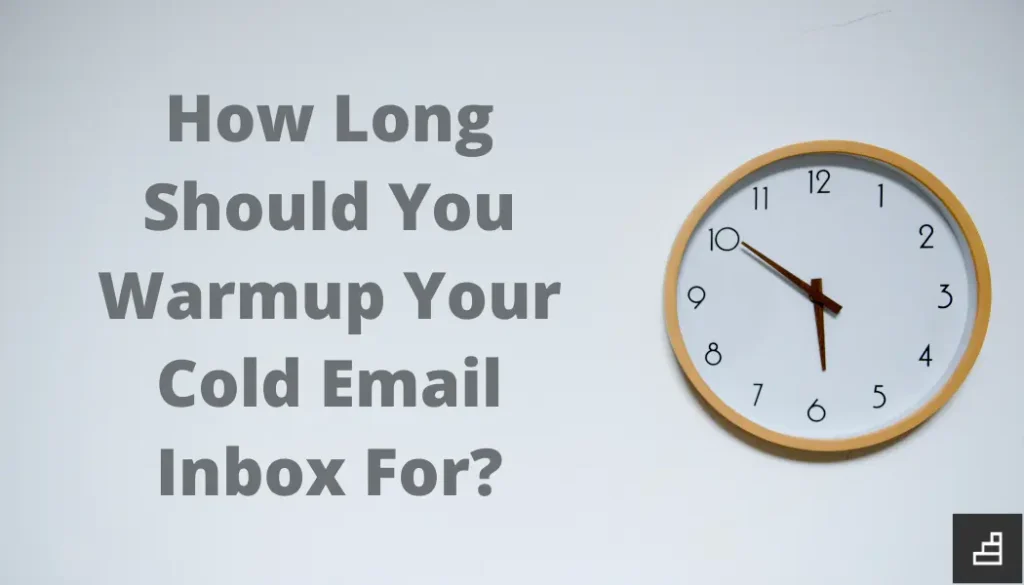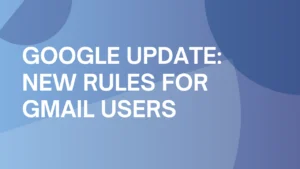
How Long Should You Warmup Your Cold Email Inbox For?
For anyone preparing a sender domain for future email outreach, the process of warming up it’s associated IP address is an important step for achieving the highest deliverability rates possible for a cold email campaign. While the process of warming up a new domain for outreach is a long and ongoing process that requires time and patience, it is extremely important for maintaining the viability of your sender domains over a long period of time.
Sender domains can become unviable to use for outreach purposes over time if they are left dormant. A dormant sender domain that all of a sudden begins sending out a hundred or a thousand emails a day is reason enough for ESP providers to shut down or blacklist an email workspace, so what should you be doing in order to prepare these sender domains for outreach, and why does the process of inbox warming take so long? In this article I will explain in more detail as to why the warming process takes a long time, and why this warming duration is so important for the deliverability and longevity of your sender domain.
What Is Inbox Warming?
The process of preparing an email address for email outreach is commonly referred to as “Warming Up” an inbox, where you build up sender activity over a long duration of time under an inbox to ensure that the email address and sender domain do not become deactivated, blacklisted, or automatically marked as spam when you begin to send outreach emails.
This process is typically done with newly created email addresses, but also benefits older email addresses that have had issues with deliverability in the past. Especially if a noticeable portion of their outgoing mail is either landing in a spam folder or blocked entirely by an email server due to either being blacklisted or associated with a domain that has a poor reputation.
Warming up an email inbox essentially is recreating the way a typical person will use an email address. Just by using your email address normally, like sending outgoing mail to other existing users, you are ‘warming it up’. When you are reading your emails, marking certain messages as important, and engaging in email threads with multiple other email addresses, you are building up your domain reputation in a way that shows that your account is being controlled by a real human being and is not being used to send out unsolicited emails that are trying to mislead/scam/defraud any other real people using their email inbox.
Inbox warming is a way of demonstrating that you have created an inbox, or registered a sender domain, for non nefarious purposes by engaging in consistent positive email engagement over a long stretch of time. Scammers or solicitors typically will never wait weeks or even months to send out emails, so by engaging in inbox warming, this helps to differentiate your own outreach from that of someone trying to
Why Should I Be Warming Up My Sender Domains?
All sender domains should be properly warmed for 45-90 days prior to performing any type of engagement at all under them if you want to achieve the highest deliverability possible. The reason why the warmup process for a domain is so important is that it builds up a sender history under your inbox, your domain, as well as the IP addresses of your mail server/domain. This sender history is important to have because it serves as a point of reference for ESP providers when determining how trustworthy your emails are when recipients’ mail servers are deciding on receiving them.
The primary reason, outside of deliverability for why you should be warming up your sender domains, is due to the nature of how ESP and ISP providers treat domains in general. Later in this article, I will be going over the reasons why it’s important to warm up an inbox for 4-6 weeks prior to outreach. In general, ESP and ISP providers want to see an inbox and domain be used on a consistent basis in order to get an idea on the type of user who owns this domain/inbox.
People utilize email in many different ways, for many different reasons, and many different purposes that aren’t related to email outreach. ESP and ISP providers need to be able to differentiate between reliable senders and non-reliable senders who utilize email to send out malicious or spammy content that can cause a disruption or issue for other recipients. Inbox warming helps to set a tone for your sender domain, differentiating you from those trying to disrupt the email flow of other users.
Why Does Inbox Warming Take So Long?
So, why do we recommend that users warm up for 45-90 days prior to performing any type of outreach at all? In short, the reason we recommend such a long warming period is that a longer duration of email activity helps tremendously with deliverability. ESP providers do not want to see people signing up for workspaces under brand new domains, and attempting to send out massive amounts of emails right away. Starting outreach right away under a new domain makes it harder for ESP providers to determine how trustworthy a new user of their service is, as well as makes it harder for providers to understand what you are trying to accomplish under a workspace, so the warming process essentially sets a baseline of the type of email activity that will be occurring under this domain going forward.
While the vast majority of people who sign up for an email workspace simply want an email address under their new domain or company, a small minority of these users are simply signing up for new workspaces to blast out harmful email addresses for malicious purposes, and just repeating the process every time their domain gets blacklisted, or their ESP provider bans their workspace under said domain. It’s a complicated process to keep these spammers out, so for normal users to prove that they are reputable senders, they need to prove to providers that their outreach is trustworthy, and not containing any type of scam or solicitation.
So how do normal users demonstrate that their sender domain is trustworthy and not going to be a source of spam? The answer is maintaining consistent positive email engagement (CPEE) under each inbox you plan on utilizing for outreach in the future and maintaining consistent sending volumes over a long duration of time. Earlier I mentioned that the ideal window for warming is 45-90 days. While this is an extremely long time to wait when you just want to start sending out emails, the reason why this window of time is suggested is due to how email service providers calculate and build up sender reputation.
Email providers want to see a long duration of normal email activity use. In the next section of this article I will go over in more detail on how CPEE helps to build up this trust under your sender domain, but in general ESP providers want to see users utilizing their service as a normal email address user would, over a long duration of time. In general, the longer this activity is occurring, the better it is for your sender reputation, but there is a soft cap on this since typically ESP providers will look at the past 45-90 days of activity under an inbox when determining the sender reputation of a sender domain on their end.
The reason why they will typically look at the past 3 months specifically is a mystery on our end as email marketers, but most likely they do this since if an email address is in use for 3 months straight, it’s a pretty good indication that this inbox is in use by an actual person and not going to be used for spam blasts or malicious intent. A good rule of thumb to consider when preparing a sender domain is that all activity you are engaging in, whether manual or automated, will typically help to differentiate yourself from spammers who are not taking the time to properly prepare their sender domains for outreach.
Consistent Positive Email Engagement (CPEE)
So what exactly are ESP providers looking at when it comes to calculating sender reputation? Earlier I used the term CPEE (Consistent Positive Email Engagement) in reference towards building up sender reputation. This refers to the process of sending, receiving, and engaging with the emails that come into your inbox on a normal basis.
When you are utilizing an email address for basic use and communication, there are a lot of activities and engagement you perform under your inbox that you may not even realize contribute towards sender reputation. Simply opening up an email, replying back to an email you received from a friend, or even adding someone to an email thread, are all activities that ESP providers pay attention to when determining the trustworthiness of an email address/sender domain. The reason they pay attention to this activity is because spammers, spoofers, and scammers will virtually never take the time to properly warm up their sender domains and perform these types of basic activities that normal email users would perform. Just simply reading incoming mail and marking it as important on a daily basis is enough to differentiate yourself from these types of malicious users.
The automation we developed at Warmup Inbox effectively simulates this average use behavior of an inbox:
- We will routinely connect to your inbox throughout the day and simply read through the emails sent out via other users of the platform to your own inbox
- Reply to a certain percentage of them
- Mark a few of them as important
- Go into your spam folder and automatically correct any emails that may have been accidentally sorted here
- Whitelist and correctly identify these emails as not spam and do the same for your own warming emails that may end up in a recipients spam folder.
This inter-engagement between email addresses within the Warmup Network essentially builds up a solid foundation for your sender domains, giving multiple points of reference to ESP providers that you are utilizing your domain and email address in a way that isn’t harmful or disruptive to other users under their service, or disrupting the email activity of email address owners under other ESP providers.

Preserving Sender Reputation For The Future (Always Be Warming)
So we have gone into detail on why warming up an inbox is so important for deliverability, as well as why it’s important to warm sender domains for up to 45-90 days prior to outreach. Once this duration is over, what now?
If you have ever written into Warmup Inbox, you will know that we strongly recommend for users to continuously warm up their sender domains even if they are not planned on being used within the coming months. The reason for this is because of CPEE. As I have touched on earlier in this article, CPEE refers to having consistent positive email engagement occurring under all sender domains that you have used, or plan on using for outreach. We also touched on how continuous use of email addresses under a sender domain is so important for long term sender reputation. We stress this continuous use because any type of dormant activity can essentially reverse the process of warming, in that once there are signs showing an email address is becoming dominant and reducing their overall daily sending volume, ESP providers take that as an indication that an inbox, or sender domain has been abandoned.
While there are no direct net negative effects when a domain becomes inactive, the issues arise when you attempt to revive these domains again in the future, since any type of dormant domain will be treated even if you warmed it up for months prior.
As an example, say you registered a domain, set up a workspace under it, got it properly set up as a sender domain, and warmed it for 90 days prior to an outreach campaign. And in this example, say you had great deliverability rates under this domain when you actually performed your outreach campaign. Once this example campaign comes to a close and you have no further needs for outreach, you stop all email activity and stop actively logging into these inboxes and using them for a few months. This lack of activity will essentially revert your sender reputation, in that all CPEE you have built up prior will not be considered with current sender reputation calculations being performed by ESP providers.
Suppose you are a company, a startup, or even an individual trying to push your own outreach out to a larger audience. In that case, you should always be warming your sender domains because otherwise your initial investment in these domains will be wasted. Dominate activity is one of the biggest killers of sender domains, since any type of jump in activity is enough for ESP providers to flag/disable sender inboxes if they feel that a sender domain was hijacked or spoofed.

Conclusion
Warming up all sender domains or inboxes for outreach is a critical step for ensuring that you reach the highest deliverability possible from your contact list. While the process may take some time, it can greatly help you to reach the main inbox of your recipients more often while ensuring that your sender domains stay healthy and active.



